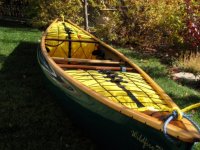We'll go back in time for a little history of the double blade in canoes. If the thought of that horrifies you , don't read!
Not my opinion. I have a copy of John Jennings The Canoe. Its a very nice coffee table book but more.
Two of the chapters are Paddling for Pleasure in the Northeastern States, and Fast Paddles and Fast Boats. The years covered are from 1860-1900 in these chapters.
The Rob Roy is generally recognized as the craft that started recreational canoeing. John MacGregor was a Brit. He used a double blade. George Washington Sears continued this sort of paddling with the Adirondack Pack Canoe.. very light allowing bushwhacking to mountain ponds. The Natives of course had no part in this..
There are pictures and sketches in the book of double blading in canoes from 1890. A sketch also shows persons of Euro descent paddling a Mi'kmaq brchbark with a double blade. ( even to me that seems odd) and canoers hignkneeling narrow racing canoes with double blades.
So to stir the pot, traditional paddling by the of Euro descent is ... double blading. Doesn't mean you gotta do it or like it. I sometimes hate it ( in mangrove tunnels I will go to the shortest single I have!) Sometimes its a love affair.
Like Mike I need a grab bar. Don't have one though.
So Peach part of the popularity of the double blade is that its part of Eastern canoeing history.. BTW we are very weak on dugouts and I have yet to see a dragon boat.
Not my opinion. I have a copy of John Jennings The Canoe. Its a very nice coffee table book but more.
Two of the chapters are Paddling for Pleasure in the Northeastern States, and Fast Paddles and Fast Boats. The years covered are from 1860-1900 in these chapters.
The Rob Roy is generally recognized as the craft that started recreational canoeing. John MacGregor was a Brit. He used a double blade. George Washington Sears continued this sort of paddling with the Adirondack Pack Canoe.. very light allowing bushwhacking to mountain ponds. The Natives of course had no part in this..
There are pictures and sketches in the book of double blading in canoes from 1890. A sketch also shows persons of Euro descent paddling a Mi'kmaq brchbark with a double blade. ( even to me that seems odd) and canoers hignkneeling narrow racing canoes with double blades.
So to stir the pot, traditional paddling by the of Euro descent is ... double blading. Doesn't mean you gotta do it or like it. I sometimes hate it ( in mangrove tunnels I will go to the shortest single I have!) Sometimes its a love affair.
Like Mike I need a grab bar. Don't have one though.
So Peach part of the popularity of the double blade is that its part of Eastern canoeing history.. BTW we are very weak on dugouts and I have yet to see a dragon boat.







